-
TPS51200-EP 灌/拉 DDR 终端稳压器
- 1 特性
- 2 应用范围
- 3 说明
- 4 修订历史记录
- 5 Pin Configuration and Functions
- 6 Specifications
-
7 Detailed Description
- 7.1 Overview
- 7.2 Functional Block Diagram
- 7.3
Feature Description
- 7.3.1 Sink and Source Regulator (VO Pin)
- 7.3.2 Reference Input (REFIN Pin)
- 7.3.3 Reference Output (REFOUT Pin)
- 7.3.4 Soft-Start Sequencing
- 7.3.5 Enable Control (EN Pin)
- 7.3.6 Powergood Function (PGOOD Pin)
- 7.3.7 Current Protection (VO Pin)
- 7.3.8 UVLO Protection (VIN Pin)
- 7.3.9 Thermal Shutdown
- 7.3.10 Tracking Start-up and Shutdown
- 7.4 Device Functional Modes
- 8 Application and Implementation
- 9 Power Supply Recommendations
- 10Layout
- 11器件和文档支持
- 12机械、封装和可订购信息
- 重要声明
TPS51200-EP 灌/拉 DDR 终端稳压器
1 特性
- 输入电压:支持 2.5V 和 3.3V 电源轨
- VLDOIN 电压范围:1.1V 至 3.5V
- 具有压降补偿功能的灌电流和拉电流终端稳压器
- 所需最小输出电容为 20μF(通常为 3 × 10μF MLCC),用于存储器终端 应用 (DDR)
- 用于监视输出稳压的 PGOOD
- EN 输入
- REFIN 输入允许直接或通过电阻分压器灵活进行输入跟踪
- 远程感测 (VOSNS)
- ±10mA 缓冲基准 (REFOUT)
- 内置软启动,欠压锁定 (UVLO) 和过流限制 (OCL)
- 热关断
- 符合 DDR 和 DDR2 JEDEC 规范
- 支持 DDR3、低功耗 DDR3 和 DDR4 VTT 应用
- 带有散热焊盘的 10 引脚超薄小外形尺寸无引线 (VSON) 封装
-
支持国防、航天和医疗 应用
- 受控基线
- 一个组装和测试场所
- 一个制造场所
- 支持军用温度范围(-55°C 至 125°C)
- 延长的米6体育平台手机版_好二三四使用寿命周期
- 延长的米6体育平台手机版_好二三四变更通知
- 米6体育平台手机版_好二三四可追溯性
2 应用范围
- 用于 DDR、DDR2、DDR3、低功耗 DDR3 和 DDR4 的存储器终端稳压器
- 笔记本、台式机和服务器
- 电信和数据通信
- 基站
- 液晶 (LCD) 电视和等离子 (PDP) 电视
- 复印机和打印机
- 机顶盒
3 说明
TPS51200-EP 器件是一款灌电流和拉电流双倍数据速率 (DDR) 终端稳压器,专用于空间问题是重要考量因素的低输入电压、低成本、低噪声系统。
TPS51200-EP 能够保持快速瞬态响应,最低仅需 20μF 输出电容。TPS51200-EP 支持远程感测功能并且可满足 DDR、DDR2、DDR3、低功耗 DDR3 和 DDR4 VTT 总线的所有电源要求。
此外,TPS51200-EP 还提供一个开漏 PGOOD 信号监测输出稳压,提供一个 EN 信号在 S3(挂起至 RA4M)期间针对 DDR 进行 VTT 放电。
TPS51200-EP 采用带散热焊盘的高效散热型 10 引脚超薄小外形尺寸无引线 (VSON) 封装,无铅且绿色环保。其额定工作温度范围为 -55°C 至 +125°C。
器件信息(1)
| 器件型号 | 封装 | 封装尺寸(标称值) |
|---|---|---|
| TPS51200-EP | VSON (10) | 3.00mm x 3.00mm |
- 要了解所有可用封装,请见数据表末尾的可订购米6体育平台手机版_好二三四附录。
简化的 DDR 应用
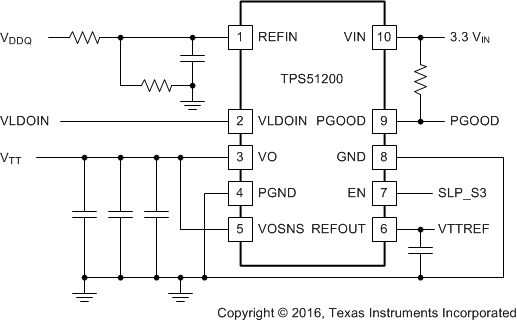
4 修订历史记录
| 日期 | 修订版本 | 注释 |
|---|---|---|
| 2016 年 6 月 | * | 最初发布。 |
5 Pin Configuration and Functions
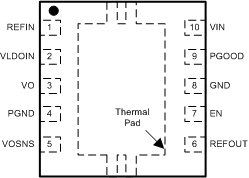
Pin Functions
| PIN | I/O(2) | DESCRIPTION | |
|---|---|---|---|
| NAME | NO. | ||
| EN | 7 | I | For DDR VTT application, connect EN to SLP_S3. For any other application, use the EN pin as the ON/OFF function. |
| GND | 8 | G | Signal ground. Connect to negative terminal of the output capacitor. |
| PGND(1) | 4 | G | Power ground output for the LDO. |
| PGOOD | 9 | O | PGOOD output. Indicates regulation. |
| REFIN | 1 | I | Reference input. |
| REFOUT | 6 | O | Reference output. Connect to GND through 0.1-μF ceramic capacitor. |
| VIN | 10 | I | 2.5-V or 3.3-V power supply. A ceramic decoupling capacitor with a value between 1-μF and 4.7-μF is required. |
| VLDOIN | 2 | I | Supply voltage for the LDO. |
| VO | 3 | O | Power output for the LDO. |
| VOSNS | 5 | I | Voltage sense input for the LDO. Connect to positive terminal of the output capacitor or the load. |
6 Specifications
6.1 Absolute Maximum Ratings
over operating junction temperature range (unless otherwise noted) (1)| MIN | MAX | UNIT | ||
|---|---|---|---|---|
| Input voltage(2) | REFIN, VIN, VLDOIN, VOSNS | –0.3 | 3.6 | V |
| EN | –0.3 | 6.5 | ||
| PGND to GND | –0.3 | 0.3 | ||
| Output voltage(2) | REFOUT, VO | –0.3 | 3.6 | V |
| PGOOD | –0.3 | 6.5 | ||
| Operating junction temperature, TJ | –55 | 150 | °C | |
| Storage temperature, Tstg | –55 | 150 | °C | |
6.2 ESD Ratings
| VALUE | UNIT | |||
|---|---|---|---|---|
| V(ESD) | Electrostatic discharge | Human body model (HBM), per ANSI/ESDA/JEDEC JS-001(1) | ±2000 | V |
| Charged device model (CDM), per JEDEC specification JESD22-C101(2) | ±500 | |||
6.3 Recommended Operating Conditions
over operating junction temperature range (unless otherwise noted)| MIN | NOM | MAX | UNIT | ||
|---|---|---|---|---|---|
| Supply voltages | VIN | 2.375 | 3.5 | V | |
| Voltage | EN, VLDOIN, VOSNS | –0.1 | 3.5 | V | |
| REFIN | 0.5 | 1.8 | |||
| PGOOD, VO | –0.1 | 3.5 | |||
| REFOUT | –0.1 | 1.8 | |||
| PGND | –0.1 | 0.1 | |||
| Operating junction temperature, TJ | –55 | 125 | °C | ||
6.4 Thermal Information
| THERMAL METRIC(1) | TPS51200-EP | UNIT | |
|---|---|---|---|
| DRC (VSON) | |||
| 10 PINS | |||
| RθJA | Junction-to-ambient thermal resistance | 55.6 | °C/W |
| RθJC(top) | Junction-to-case (top) thermal resistance | 84.6 | °C/W |
| RθJB | Junction-to-board thermal resistance | 30 | °C/W |
| ψJT | Junction-to-top characterization parameter | 5.5 | °C/W |
| ψJB | Junction-to-board characterization parameter | 30.1 | °C/W |
| RθJC(bot) | Junction-to-case (bottom) thermal resistance | 10.9 | °C/W |
6.5 Electrical Characteristics
Over recommended junction temperature range, VVIN = 3.3 V, VVLDOIN = 1.8 V, VREFIN = 0.9 V, VVOSNS = 0.9 V, VEN = VVIN, COUT = 3 × 10 μF and circuit shown in (unless otherwise noted)| PARAMETER | TEST CONDITIONS | MIN | TYP | MAX | UNIT | |
|---|---|---|---|---|---|---|
| SUPPLY CURRENT | ||||||
| IIN | Supply current | TJ = 25 °C, VEN = 3.3 V, no load | 0.7 | 1 | mA | |
| IIN(SDN) | Shutdown current | TJ = 25 °C, VEN = 0 V, VREFIN = 0, no load |
65 | 80 | μA | |
| TJ = 25 °C, VEN = 0 V, VREFIN > 0.4 V, no load | 200 | 400 | ||||
| ILDOIN | Supply current of VLDOIN | TJ = 25 °C, VEN = 3.3 V, no load | 1 | 50 | μA | |
| ILDOIN(SDN) | Shutdown current of VLDOIN | TJ = 25 °C, VEN = 0 V, no load | 0.1 | 50 | μA | |
| INPUT CURRENT | ||||||
| IREFIN | Input current, REFIN | VEN = 3.3 V | 1 | μA | ||
| VO OUTPUT | ||||||
| VVOSNS | Output DC voltage, VO | VREFOUT = 1.25 V (DDR1), IO = 0 A | 1.25 | V | ||
| –15 | 15 | mV | ||||
| VREFOUT = 0.9 V (DDR2), IO = 0 A | 0.9 | V | ||||
| –15 | 15 | mV | ||||
| VLDOIN = 1.5 V, VREFOUT = 0.75 V (DDR3), IO = 0 A | 0.75 | V | ||||
| –15 | 15 | mV | ||||
| VVOTOL | Output voltage tolerance to REFOUT | –2 A < IVO < 2 A | –25 | 25 | mV | |
| IVOSRCL | VO source current Limit | With reference to REFOUT, VOSNS = 90% × VREFOUT |
3 | 4.5 | A | |
| IVOSNCL | VO sink current Limit | With reference to REFOUT, VOSNS = 110% × VREFOUT |
3.5 | 5.5 | A | |
| IDSCHRG | Discharge current, VO | VREFIN = 0 V, VVO = 0.3 V, VEN = 0 V, TJ = 25°C | 18 | 25 | Ω | |
| POWERGOOD COMPARATOR | ||||||
| VTH(PG) | VO PGOOD threshold | PGOOD window lower threshold with respect to REFOUT | –23.5% | –20% | –17.5% | |
| PGOOD window upper threshold with respect to REFOUT | 17.5% | 20% | 23.5% | |||
| PGOOD hysteresis | 5% | |||||
| tPGSTUPDLY | PGOOD start-up delay | Start-up rising edge, VOSNS within 15% of REFOUT | 2 | ms | ||
| VPGOODLOW | Output low voltage | ISINK = 4 mA | 0.4 | V | ||
| tPBADDLY | PGOOD bad delay | VOSNS is outside of the ±20% PGOOD window | 10 | μs | ||
| IPGOODLK | Leakage current(1) | VOSNS = VREFIN (PGOOD high impedance), VPGOOD = VVIN + 0.2 V | 1 | μA | ||
| REFIN AND REFOUT | ||||||
| VREFIN | REFIN voltage range | 0.5 | 1.8 | V | ||
| VREFINUVLO | REFIN undervoltage lockout | REFIN rising | 360 | 390 | 420 | mV |
| VREFINUVHYS | REFIN undervoltage lockout hysteresis | 20 | mV | |||
| VREFOUT | REFOUT voltage | REFIN | V | |||
| VREFOUTTOL | REFOUT voltage tolerance to VREFIN | –10 mA < IREFOUT < 10 mA, VREFIN = 1.25 V |
–15 | 15 | mV | |
| –10 mA < IREFOUT < 10 mA, VVREFIN = 0.9 V |
–15 | 15 | ||||
| –10 mA < IREFOUT < 10 mA, VREFIN = 0.75 V |
–15 | 15 | ||||
| –10 mA < IREFOUT < 10 mA, VREFIN = 0.6 V |
–15 | 15 | ||||
| IREFOUTSRCL | REFOUT source current limit | VREFOUT = 0 V | 10 | 40 | mA | |
| IREFOUTSNCL | REFOUT sink current limit | VREFOUT = 0 V | 10 | 40 | mA | |
| UVLO AND EN LOGIC THRESHOLD | ||||||
| VVINUVVIN | UVLO threshold | Wake up, TJ = 25°C | 2.2 | 2.3 | 2.375 | V |
| Hysteresis | 50 | mV | ||||
| VENIH | High-level input voltage | Enable | 1.7 | V | ||
| VENIL | Low-level input voltage | Enable | 0.3 | V | ||
| VENYST | Hysteresis voltage | Enable | 0.5 | V | ||
| IENLEAK | Logic input leakage current | EN, TJ = 25°C | –1 | 1 | μA | |
| THERMAL SHUTDOWN | ||||||
| TSON | Thermal shutdown threshold(1) | Shutdown temperature | 150 | °C | ||
| Hysteresis | 25 | |||||
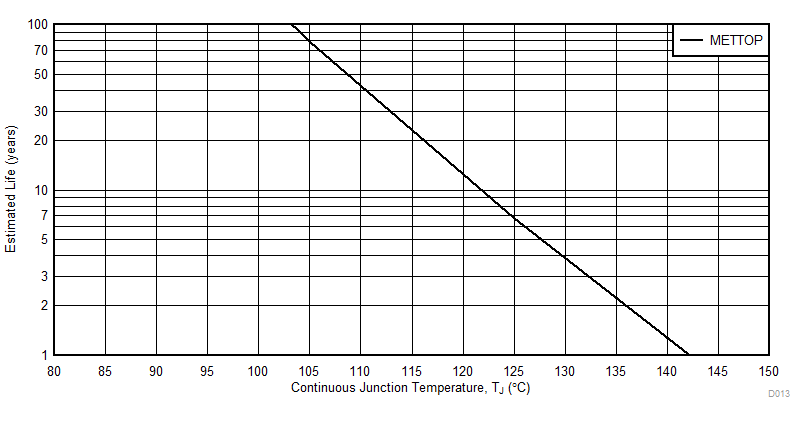
6.6 Typical Characteristics
3 × 10-µF MLCCs (0805) are used on the output.
| VVIN = 3.3 V | DDR |
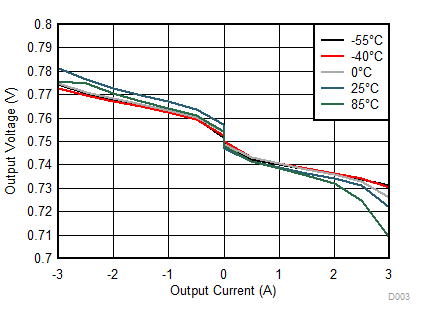
| VVIN = 3.3 V | DDR3 |
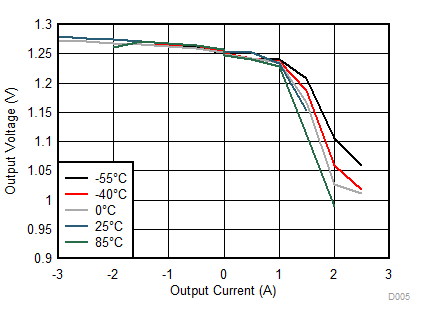
| VVIN = 2.5 V | DDR |
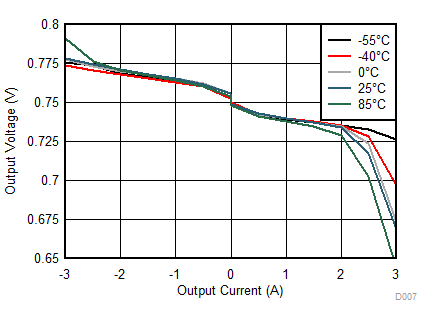
| VVIN = 2.5 V | DDR3 |
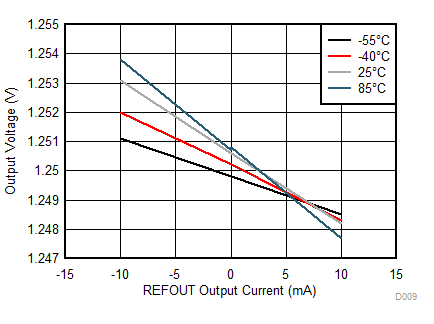
| DDR |
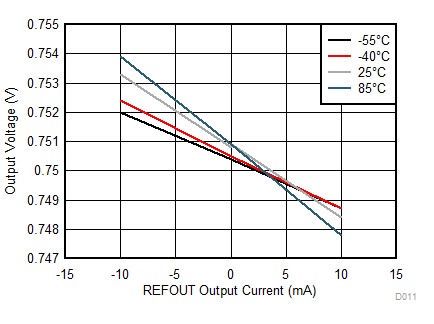
| DDR3 |
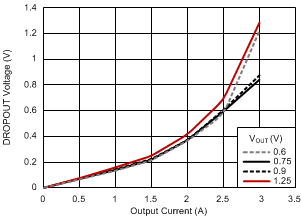
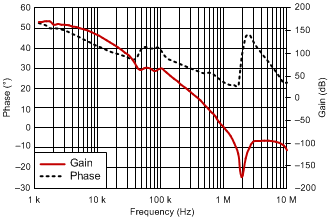
| DDR3 |
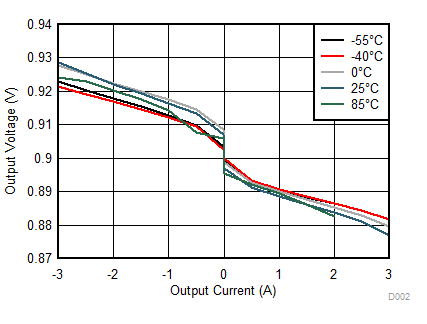
| VVIN = 3.3 V | DDR2 |
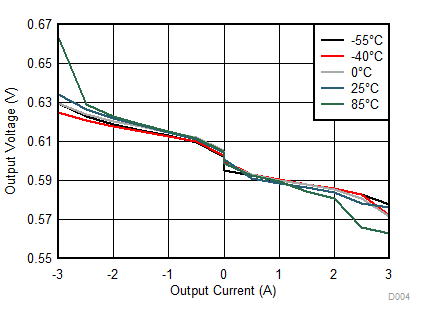
| VVIN = 3.3 V | LP DDR3 or DDR4 |
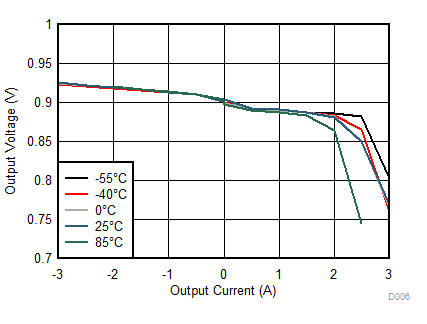
| VVIN = 2.5 V | DDR2 |
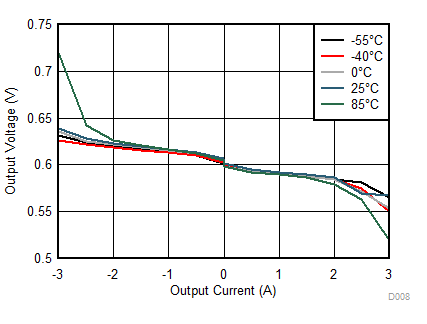
| VVIN = 2.5 V | LP DDR3 or DDR4 |
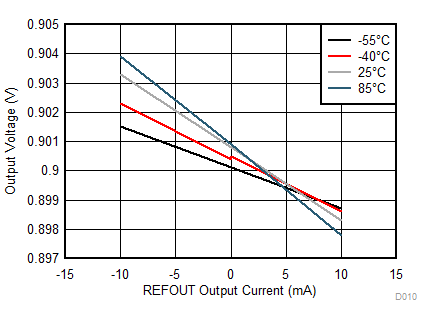
| DDR2 |
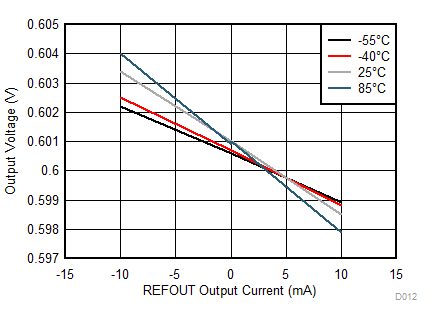
| LP DDR3 or DDR4 |
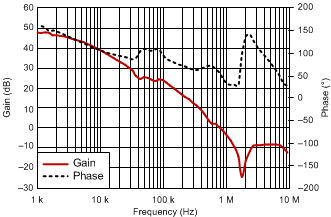
| DDR2 |
7 Detailed Description
7.1 Overview
The TPS51200-EP device is a sink and source double data rate (DDR) termination regulator specifically designed for low-input voltage, low-cost, low-noise systems where space is a key consideration.
The device maintains a fast transient response and only requires a minimum output capacitance of 20 μF. The device supports a remote sensing function and all power requirements for DDR, DDR2, DDR3, Low-Power DDR3, and DDR4 VTT bus termination.
7.2 Functional Block Diagram
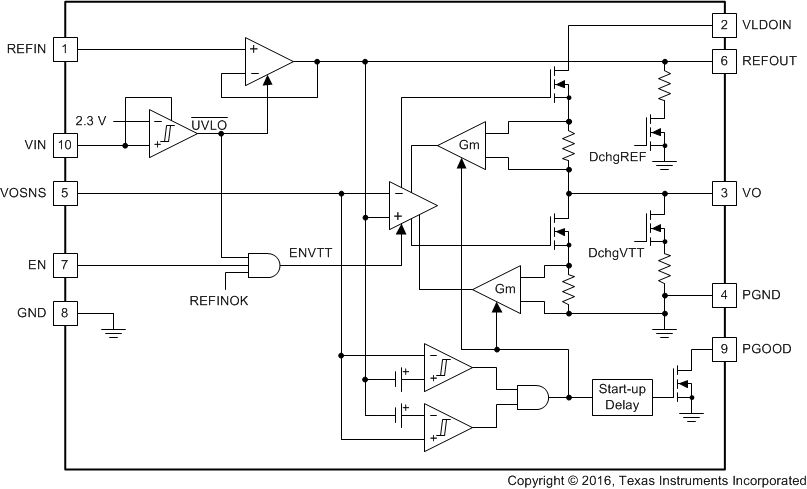
7.3 Feature Description
7.3.1 Sink and Source Regulator (VO Pin)
The TPS51200-EP is a sink and source tracking termination regulator specifically designed for low-input voltage, low-cost, and low-external component count systems where space is a key application parameter. The device integrates a high-performance, low-dropout (LDO) linear regulator that is capable of both sourcing and sinking current. The LDO regulator employs a fast feedback loop so that small ceramic capacitors can be used to support the fast load transient response. To achieve tight regulation with minimum effect of trace resistance, connect a remote sensing terminal, VOSNS, to the positive terminal of each output capacitor as a separate trace from the high-current path from VO.
7.3.2 Reference Input (REFIN Pin)
The output voltage, VO, is regulated to REFOUT. When REFIN is configured for standard DDR termination applications, REFIN can be set by an external equivalent ratio voltage divider connected to the memory supply bus (VDDQ). The TPS51200-EP device supports REFIN voltages from 0.5 V to 1.8 V, making it versatile and ideal for many types of low-power LDO applications.
7.3.3 Reference Output (REFOUT Pin)
When it is configured for DDR termination applications, REFOUT generates the DDR VTT reference voltage for the memory application. It is capable of supporting both a sourcing and sinking load of 10 mA. REFOUT becomes active when REFIN voltage rises to 0.39 V and VIN is above the UVLO threshold. When REFOUT is less than 0.375 V, it is disabled and subsequently discharges to GND through an internal 10-kΩ MOSFET. REFOUT is independent of the EN pin state.
7.3.4 Soft-Start Sequencing
A current clamp implements the soft-start function of the VO pin. The current clamp allows the output capacitors to be charged with low and constant current, providing a linear ramp-up of the output voltage. When VO is outside of the powergood (PGOOD) window, the current clamp level is one-half of the full overcurrent limit (OCL) level. When VO rises or falls within the PGOOD window, the current clamp level switches to the full OCL level. The soft-start function is completely symmetrical and the overcurrent limit works for both directions. The soft-start function works not only from GND to the REFOUT voltage, but also from VLDOIN to the REFOUT voltage.
7.3.5 Enable Control (EN Pin)
When EN is driven high, the VO regulator begins normal operation. When the device drives EN low, VO discharges to GND through an internal 18-Ω MOSFET. REFOUT remains on when the device drives EN low. Ensure that the EN pin voltage remains lower than or equal to VVIN at all times.
7.3.6 Powergood Function (PGOOD Pin)
The TPS51200-EP device provides an open-drain PGOOD output that goes high when the VO output is within ±20% of REFOUT. PGOOD de-asserts within 10 μs after the output exceeds the size of the PGOOD window. During initial VO start-up, PGOOD asserts high 2 ms (typ) after the VO enters PGOOD window. Because PGOOD is an open-drain output, a pull-up resistor with a value between 1 kΩ and 100 kΩ, placed between PGOOD and a stable active supply voltage rail, is required.
7.3.7 Current Protection (VO Pin)
The LDO has a constant overcurrent limit (OCL). The OCL level reduces by one-half when the output voltage is not within the PGOOD window. This reduction is a non-latch protection.
7.3.8 UVLO Protection (VIN Pin)
For VIN undervoltage lockout (UVLO) protection, the TPS51200-EP monitors VIN voltage. When the VIN voltage is lower than the UVLO threshold voltage, both the VO and REFOUT regulators are powered off. This shutdown is a non-latch protection.
7.3.9 Thermal Shutdown
The TPS51200-EP monitors junction temperature. If the device junction temperature exceeds the threshold value, (typically 150°C), the VO and REFOUT regulators both shut off, discharged by the internal discharge MOSFETs. This shutdown is a non-latch protection.
7.3.10 Tracking Start-up and Shutdown
The TPS51200-EP also supports tracking start-up and shutdown when the EN pin is tied directly to the system bus and not used to turn on or turn off the device. During tracking start-up, VO follows REFOUT once REFIN voltage is greater than 0.39 V. REFIN follows the rise of VDDQ rail through a voltage divider. The typical soft-start time (tSS) for the VDDQ rail is approximately 3 ms, however it may vary depending on the system configuration. The soft-start time of the VO output no longer depends on the OCL setting, but it is a function of the soft-start time of the VDDQ rail. PGOOD is asserted 2 ms after VVO is within ±20% of REFOUT. During tracking shutdown, the VO pin voltage falls following REFOUT until REFOUT reaches 0.37 V. When REFOUT falls below 0.37 V, the internal discharge MOSFETs turn on and quickly discharge both REFOUT and VO to GND. PGOOD is deasserted once VO is beyond the ±20% range of REFOUT. Figure 18 shows the typical timing diagram for an application that uses tracking start-up and shutdown.
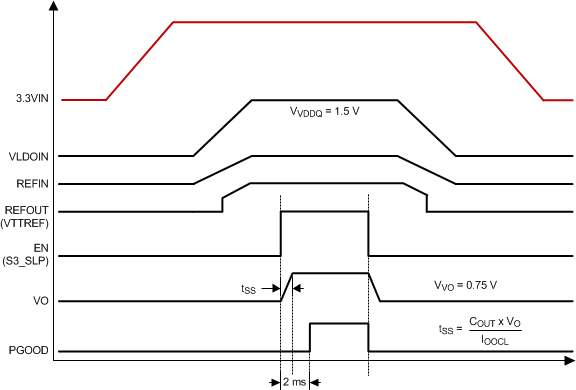 Figure 17. Typical Timing Diagram for S3 and Pseudo-S5 Support
Figure 17. Typical Timing Diagram for S3 and Pseudo-S5 Support
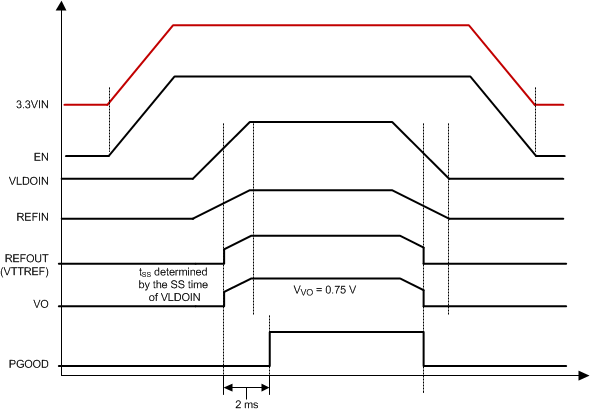 Figure 18. Typical Timing Diagram of Tracking Start-up and Shutdown
Figure 18. Typical Timing Diagram of Tracking Start-up and Shutdown
7.4 Device Functional Modes
7.4.1 Low-Input Voltage Applications
TPS51200-EP can be used in an application system that offers either a 2.5-V rail or a 3.3-V rail. If only a 5-V rail is available, consider using the TPS51100 device as an alternative. The TPS51200-EP device has a minimum input voltage requirement of 2.375 V. If a 2.5-V rail is used, ensure that the absolute minimum voltage (both DC and transient) at the device pin is be 2.375 V or greater. The voltage tolerance for a 2.5-V rail input is between –5% and 5% accuracy, or better.
7.4.2 S3 and Pseudo-S5 Support
The TPS51200-EP provides S3 support by an EN function. The EN pin could be connected to an SLP_S3 signal in the end application. Both REFOUT and VO are on when EN = high (S0 state). REFOUT is maintained while VO is turned off and discharged via an internal discharge MOSFET when EN = low (S3 state). When EN = low and the REFIN voltage is less than 0.39 V, TPS51200-EP enters pseudo-S5 state. Both VO and REFOUT outputs are turned off and discharged to GND through internal MOSFETs when pseudo-S5 support is engaged (S4 or S5 state). Figure 17 shows a typical start-up and shutdown timing diagram for an application that uses S3 and pseudo-S5 support.